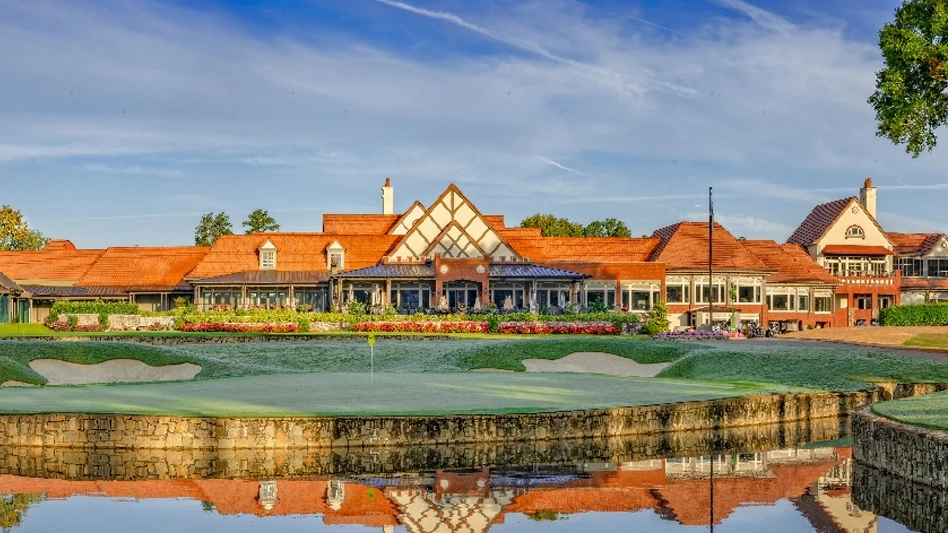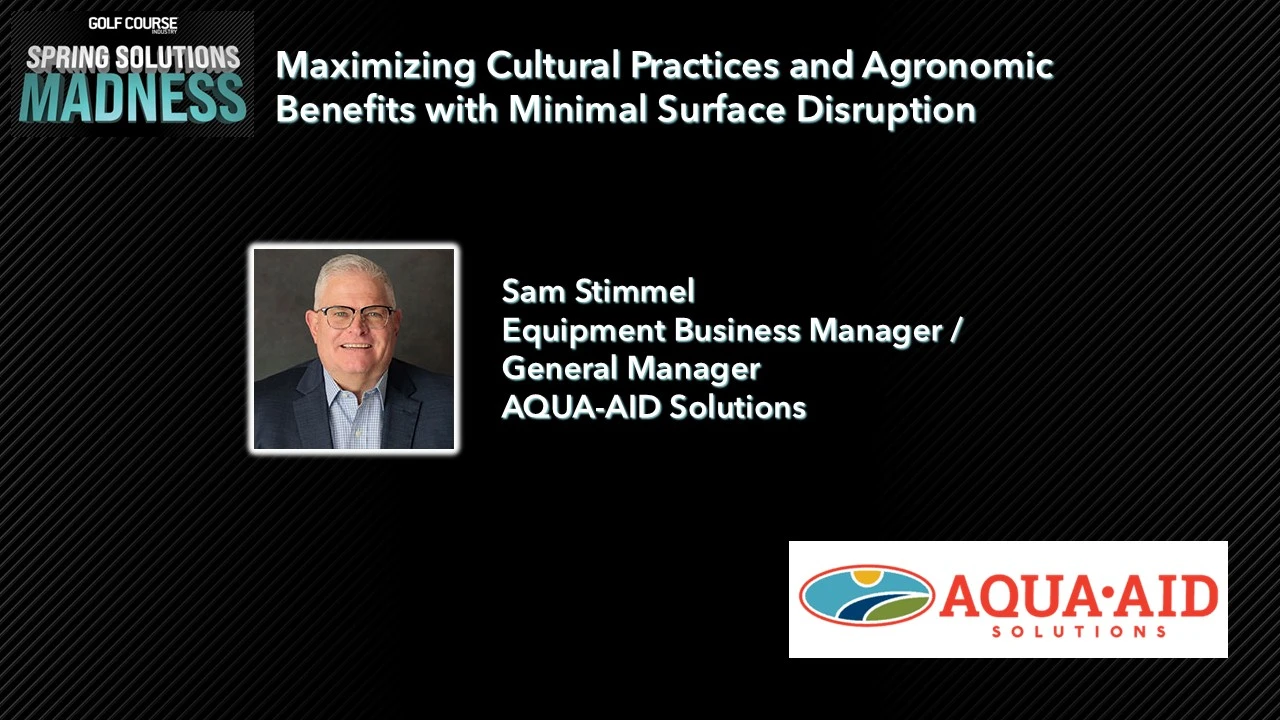In 1998, Midlothian Country Club celebrated its centennial by junking its 1960s-style clubhouse and replacing it with a more fitting, Colonial-revival style model. With another anniversary looming – Midlothian was site of the 1914 U.S. Open – the Illinois club revived its 106-year-old golf course by completely renovating its bunkers.
Working in concert with certified golf course superintendent Dave Behrman and with sister construction division Golf Creations, Marengo, Ill.-based Lohmann Golf Designs recently finished its refurbishment of Midlothian’s 82 bunkers in a classic, steep-faced, flat-bottomed style – a look club members favored and even help select. LGD’s master plan also resulted in the relocation of dozens of fairway bunkers that had become meaningless because of decades of tree growth and technological advancement.
Golf Creations broke ground on the $882,000 project immediately after Labor Day in 2003. Ultimately, progress came quick. Eighty percent of the new bunkers were finished before snow fell in winter, and all of Midlothian’s renovated bunkers debuted shortly after the course reopened for play in 2004.
Improvement needed
|
|
Midlothian’s vintage course dates to 1898. It was designed by H.G. Tweedie, who laid the original tracks at a host of esteemed Illinois clubs, including Exmoor, LaGrange, Bryn Mawr and Rockford. Yet throughout time, Midlothian developed troubling issues common to many designs of this vintage. The main problem: Trees had grown between the playing corridors and minimized the impact of the course’s fairway bunkers, many of which had become obscured by the encroaching forest.
“During the 1960s, the club lost all the elm trees on the golf course to disease,” Behrman says. “So, the members instituted a very aggressive tree planting program, dedicated a lot of money on an annual basis and never stopped. The golf course became so overplanted that many fairway bunkers were basically surrounded by trees. The Chicago District Golf Association didn’t even consider them hazards anymore.”
CDGA officials told the club its course rating would never increase until the bunkers were brought more into play.
Remedying this situation came down to two choices: removing scads of mature trees and refurbishing the bunkers as they lay or moving the bunkers closer to the fairway. LGD founder and principal Bob Lohmann opted for the latter.
“Hundreds of trees would have been sacrificed to bring these fairway bunkers back into play where they lay, and frankly, that just wasn’t going to happen,” says Lohmann, a past president of the American Society of Golf Course Architects. “Still, we worked with the club for more than five years before deciding to re-establish these bunkers away from the tree line, closer to the fairway corridors. Midlothian is fortunate because its fairway widths remain generous. There was plenty of room to reintroduce these hazards without sacrificing the playability of the course.
“We’ve also repositioned these bunkers based on modern club and ball technology, re-establishing them farther down the fairways, in some cases, to influence the appropriate target zones and landing areas,” Lohmann says. “After all, today’s balls are flying a lot farther than they did in 1898.”
|
|
Practical restoration
When it comes to renovating vintage courses like Midlothian, Lohmann is a proponent of what he terms “practical restoration,” whereby classic design features are reintroduced in the context of modern playing standards and maintenance expectations.
“For example, there weren’t more than a handful of trees on this site when the Midlothian course was built 105 years ago,” he says. “To restore the bunkering in an orthodox way, exactly where Tweedie placed them, would have meant the removal of hundreds and hundreds of trees. That’s crazy, and impractical. After a great deal of discussion with the members, we agreed to move the affected fairway bunkers, a strategy that solved the tree problems and simultaneously accounted for modern club and ball capabilities.”
LGD also solicited members’ input to help decide what form the re-established bunkers would take. Throughout time, all 82 of Midlothian’s bunkers – fairway and greenside – had degenerated into rounded pancakes of sand with little character or definition. An LGD-led field trip for members, who toured 10 different area golf clubs, helped determine the bunker style Lohmann employed.
“What we settled on was a style similar to the bunkers we recently refurbished at Knollwood [Country Club] outside Detroit,” Lohmann says. “In keeping with the vintage qualities at Midlothian, the bunker style is classic. With sod faces and flat bottoms, the look is undeniably dramatic. And the placement is far more strategic. That combination adds up to practical restoration.”
Better bunkers
Using the practical restoration strategy, club members remained involved in some of the project decisions. For example, Midlothian staff members called other clubs and members took field trips to receive feedback about different kinds of sand to help select the sand that was used.
“Three different varieties were placed in a sample bunker, and the membership practiced out of each one, then voted,” says Todd Quitno, senior architect with LGD . “The winner was Meyers Mason FA-9, from a quarry in McHenry, Ill. We like the sand they chose because it has a nice, light-tan color. It’s a good color because, after a year or two, white sand tends to get dirty anyway. It’s also very playable, and not too soft and not too firm.”
The type of sand and bunker design contributed to improved bunker drainage.
“Of the 82 bunkers we had here, 79 of them had 100-percent drainage failure,” Behrman says. “We were constantly pumping and shoveling. If two inches of rain fell, it took us about 16 to 18 hours and 10 men to fix them. That’s 180 man-hours to restore the bunkers to what I wouldn’t even call acceptable conditions, but the members were so used to these poor conditions, they accepted it.
“Now that we’re finished, you wouldn’t believe the difference,” he says. “We recently had 3.5 inches of rain in one 36-hour period, and there was no water at all [in the bunkers]. They were perfect.”
When the project was completed, the golf course featured the same number of bunkers as before, even though some were removed and some were added.
“What’s interesting is that it feels like there are more bunkers because now they are properly placed, both strategically and aesthetically, and thus, they come into play and are seen more readily,” Quitno says. “Before, the bunkers were lost behind trees and located in other out-of-play areas. Now, they are the focal points of the golf holes.”
Behrman also decided to hand-rake the new bunkers.
“In terms of man-hours, that means the bunkers will require the same or even a higher amount of maintenance,” he says. “But we feel the new bunkers are of such a high quality that we’ve taken the course to a new level. Also, going from mechanized bunker rakes to the hand rakes will result in less disruption to the sand and less contamination in the long term. Hand-raking allows the sand to firm up and stay firm. We didn’t want any risk of contaminating the sand during a heavy rain event. It’s a trade I’m happy to make."
Behrman says the look of the bunkers – the flat bottoms with strong side mounding – brought character to the golf course.
“It’s pretty fantastic what they were able to do here,” he says. “Lohmann’s guys blended them beautifully; their shapers are artists. We dug two lakes and generated about 11,000 cubic yards of material that we used to blend these new bunker complexes into the landscape. They were able to play out the grades off the back sides of these bunkers much farther into the natural lay of the land. They look like they’ve always been there.”
All the bunkers were sodded and several fairways needed to be adjusted to accommodate the new bunker locations. Behrman’s crew made these adjustments by relocating sod.
“We ended up sodding 13 acres of bluegrass,” Behrman says. “As for the bentgrass, we moved the bentgrass displaced by the renovation and stored it on several tennis courts that weren’t being used. We watered and mowed it and applied snow mold treatments. We kept a sizable portion of it alive over the winter. We stored our practice chipping green in this way, and it came through in the spring beautifully. We had budgeted $12,000 to $15,000 for bentgrass and ended up not having to buy any. We had more than we needed.”
Time was a concern, too. LGD overcame time constraints to finish the renovation on schedule. Quitno says the project timetable was always tight and the weather at the time was a big factor in delaying the project’s start.
“We couldn’t break ground until Labor Day of 2003,” he says. “The original plan was to complete all 82 bunkers by the end of 2003, and we nearly finished on time – only because Golf Creations really ramped up its resources at the end of last year and Dave Behrman’s staff helped a lot by doing some of the drainage work in-house. Toward the end of the project, we were doing something in the neighborhood of 10 bunkers a week (start to finish), which is an unbelievable amount. The last few holes were completed in the spring of 2004.”
Financial success
Budget also was a critical factor with this project. Behrman’s crew and LGD worked together to stay on target.
“We spent our $882,000 budget, which included a $45,000 contingency fund,” Behrman says. “But the reality is, we brought the work Bob Lohmann did in at $792,000. Beyond that, we did what we call some add-on projects. We dredged some ponds, installed additional drainage, bought some new equipment to manage the new bunkers, remodeled the entire driving range and built a new practice chipping range. So, we ended up doing about $90,000 of extra work and stayed within our overall assessed budget of $882,000, which the club raised through a direct assessment.”
In particular, the club was careful not to detract players or negatively affect the club’s revenue, Behrman says. The course remained open during renovation but experienced periodic hole closings when necessary.
“My impression was that it didn’t hurt us at all, in part because we stayed open the entire time,” he says. “Actually, we allowed for longer hole closings, but Golf Creations did such a fine job, they were quite limited. From my standpoint, there was little to no impact.”
That is until members began to see the new holes, Quitno says.
“When the bunkers were completed with sand and sod, they were roped off for several weeks until they were ready for play,” he says. “The hole closings were not a problem once the membership saw the finished product they were getting. In fact, support really snowballed during the construction phase.”
Lohmann’s experience served him well in this project. He has completed more than 30 original golf course designs. Presently, LGD is working on the Canyata Club in Marshall, Ill., where nine holes are open and another nine will open for play in 2005. Also, the firm’s first East Coast design, the Mattaponi Springs Golf Club at Penola Station in Ruther Glen, Va., opened this fall.
“In some ways, original course design like our work at Canyata and Mattaponi Springs is more straightforward than renovation because you’re dealing with a blank slate,” Lohmann says. “It’s a completely different animal compared to the sort of work we undertook at Midlothian. Older clubs have histories and physical attributes that must be protected and enhanced.” GCN
Hal Phillips is president of Phillips Golf Media and is based in New Gloucester, Maine. He can be reached at onintwo@maine.rr.com.

Explore the October 2004 Issue
Check out more from this issue and find your next story to read.
Latest from Golf Course Industry
- Tartan Talks 105: Nathan Crace and Todd Quitno
- Disease Discussion 24: Let the turf talk to you
- From the publisher’s pen: Foggy intrigue
- USGA releases Water Conservation Playbook
- Vilamoura Golf courses awarded GEO Certified status
- GCSAA’s Health in Action 5K/2K reaches fundraising goal
- Landscapes Golf Management to participate in data analyzation initiative
- Reel Turf Techs: Carl Michael









